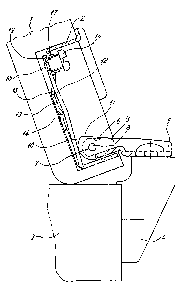Some of the information on this Web page has been provided by external sources. The Government of Canada is not responsible for the accuracy, reliability or currency of the information supplied by external sources. Users wishing to rely upon this information should consult directly with the source of the information. Content provided by external sources is not subject to official languages, privacy and accessibility requirements.
Any discrepancies in the text and image of the Claims and Abstract are due to differing posting times. Text of the Claims and Abstract are posted:
| (12) Patent: | (11) CA 2132671 |
|---|---|
| (54) English Title: | HINGE FOR FURNITURE |
| (54) French Title: | CHARNIERE DESTINEE A DU MOBILIER |
| Status: | Expired and beyond the Period of Reversal |
| (51) International Patent Classification (IPC): |
|
|---|---|
| (72) Inventors : |
|
| (73) Owners : |
|
| (71) Applicants : |
|
| (74) Agent: | SMART & BIGGAR LP |
| (74) Associate agent: | |
| (45) Issued: | 2003-12-30 |
| (22) Filed Date: | 1994-09-22 |
| (41) Open to Public Inspection: | 1995-03-24 |
| Examination requested: | 2001-06-12 |
| Availability of licence: | N/A |
| Dedicated to the Public: | N/A |
| (25) Language of filing: | English |
| Patent Cooperation Treaty (PCT): | No |
|---|
| (30) Application Priority Data: | ||||||
|---|---|---|---|---|---|---|
|
A furniture hinge has a housing (2) and a supporting
part (3) with an articulated connection and closing and
restraining device in the form of a flat spring (12) arranged
within the housing (2). The flat spring (12) works in conjunction
with a cam surface (10) during the opening movement of the hinge.
The flat spring (12) is arranged in the bottom (13) of the housing
(2), more or less parallel to this bottom part, and its middle
area is supported on a raised area (14) that is associated with
the bottom (13) of the housing. As a result of this arrangement
close to the bottom, the flat spring is very inconspicuous, and
does not detract from the appearance of the furniture. The flat
spring can be installed very easily and requires only a very
simple basic structure for the hinge type, so that the flat spring
can be used as required.
Note: Claims are shown in the official language in which they were submitted.
Note: Descriptions are shown in the official language in which they were submitted.

2024-08-01:As part of the Next Generation Patents (NGP) transition, the Canadian Patents Database (CPD) now contains a more detailed Event History, which replicates the Event Log of our new back-office solution.
Please note that "Inactive:" events refers to events no longer in use in our new back-office solution.
For a clearer understanding of the status of the application/patent presented on this page, the site Disclaimer , as well as the definitions for Patent , Event History , Maintenance Fee and Payment History should be consulted.
| Description | Date |
|---|---|
| Time Limit for Reversal Expired | 2009-09-22 |
| Letter Sent | 2008-09-22 |
| Inactive: IPC from MCD | 2006-03-11 |
| Inactive: IPC from MCD | 2006-03-11 |
| Grant by Issuance | 2003-12-30 |
| Inactive: Cover page published | 2003-12-29 |
| Pre-grant | 2003-10-07 |
| Inactive: Final fee received | 2003-10-07 |
| Notice of Allowance is Issued | 2003-09-11 |
| Notice of Allowance is Issued | 2003-09-11 |
| Letter Sent | 2003-09-11 |
| Inactive: Approved for allowance (AFA) | 2003-08-29 |
| Amendment Received - Voluntary Amendment | 2003-07-24 |
| Inactive: S.30(2) Rules - Examiner requisition | 2003-05-01 |
| Inactive: Application prosecuted on TS as of Log entry date | 2001-06-29 |
| Letter Sent | 2001-06-29 |
| Inactive: Status info is complete as of Log entry date | 2001-06-29 |
| All Requirements for Examination Determined Compliant | 2001-06-12 |
| Request for Examination Requirements Determined Compliant | 2001-06-12 |
| Application Published (Open to Public Inspection) | 1995-03-24 |
There is no abandonment history.
The last payment was received on 2003-07-28
Note : If the full payment has not been received on or before the date indicated, a further fee may be required which may be one of the following
Patent fees are adjusted on the 1st of January every year. The amounts above are the current amounts if received by December 31 of the current year.
Please refer to the CIPO
Patent Fees
web page to see all current fee amounts.
| Fee Type | Anniversary Year | Due Date | Paid Date |
|---|---|---|---|
| MF (application, 3rd anniv.) - standard | 03 | 1997-09-22 | 1997-09-12 |
| MF (application, 4th anniv.) - standard | 04 | 1998-09-22 | 1998-09-11 |
| MF (application, 5th anniv.) - standard | 05 | 1999-09-22 | 1999-08-18 |
| MF (application, 6th anniv.) - standard | 06 | 2000-09-22 | 2000-08-18 |
| Request for examination - standard | 2001-06-12 | ||
| MF (application, 7th anniv.) - standard | 07 | 2001-09-24 | 2001-07-18 |
| MF (application, 8th anniv.) - standard | 08 | 2002-09-23 | 2002-08-07 |
| MF (application, 9th anniv.) - standard | 09 | 2003-09-22 | 2003-07-28 |
| Final fee - standard | 2003-10-07 | ||
| MF (patent, 10th anniv.) - standard | 2004-09-22 | 2004-08-30 | |
| MF (patent, 11th anniv.) - standard | 2005-09-22 | 2005-09-08 | |
| MF (patent, 12th anniv.) - standard | 2006-09-22 | 2006-09-06 | |
| MF (patent, 13th anniv.) - standard | 2007-09-24 | 2007-09-05 |
Note: Records showing the ownership history in alphabetical order.
| Current Owners on Record |
|---|
| PAUL HETTICH GMBH & CO. |
| Past Owners on Record |
|---|
| ULRICH BENEKE |